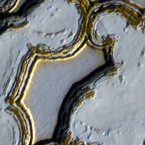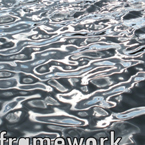Contact
Contact
Contact is a 55:00 radio art narrative focusing on the proclivity throughout
human history to seek connection and communication with the spirit spectrum, parallel
dimensions, or alien worlds beyond our own universe. Radio waves, with their ability to
traverse atmosphere and space may be one medium that can make such connection. Using
acousmatic compositions, phonography, field recordings, and sampling, Contact
imagines such a radio broadcast and what might be heard.
Timeline and Content
00:00 Sample, HBO video production opening
00:00 Sample, "Dream Drone" (freesound.org)
00:04 SFX electrical switch
00:04 SFX electrical surge
00:04 SFX white noise
01:32 Sample, "Kepler: Star KIC12268220C Light Curve Waves to Sound," NASA recording,
Connect and Collaborate with NASA > NASA Sounds
(http://www.nasa.gov/connect/sounds/)
01:32 Sample, "Shortwave radio"
01:50 Sample, "Bruckerby," track #41, The Ghost Orchid—An Introduction of
EVP
02:00 Sample, Contact (1997), opening scene audio, reversed
03:10 Sample, "Radio Luxembourg," track #17, The Ghost Orchid—An Introduction of
EVP
03:57 Production including SFX; field recording of the opening lines of Beowulf spoken in
middle English; samples from the Max Headroom television show, 1960s Radio Luxembourg
station identification, Orsen Welles and The Mercury Theatre of the Air production of "The
War of the Worlds," opening countdown of X-Minus 1 radio show, and "Is Everybody In?" from
The Stoned Immaculate, voice by William S. Burroughs over a soundtrack recorded
by Jim Morrison and The Doors
6:08 SFX/field recording busy station
6:09 Sample, "Alien Voices" (freesound.org)
6:43 Sample, "Where's Mable?", track #5, The Ghost Orchid—An Introduction of
EVP
7:06 Field recording, rail station announcement
7:25 SFX, footsteps
7:37 SFX, door opening
7:37 SFX/field recording, traffic
8:22 SFX, sports car passing
8:26 Field recording, Bay Street crosswalk, Savannah, Georgia
8:42 SFX, sports car racing
9:06 SFX, footsteps
9:23 Field recording, railroad overpass rumble
9:23 SFX, vault door closing
9:24 Sample, "Tunnel ambience" (freesound.org)
9:26 SFX, tunnel footsteps (freesound.org)
9:34 SFX, cave water drops
10:02 Sample, "Welcome to my world" (freesound.org)
10:43 Sample, "Listen" (freesound.org)
11:16 SFX, ocean surf
11:41 SFX, sail boat
11:54 SFX, scuba breathing
11:54 SFX, seagulls
12:47 SFX, canoe paddle
12:55 Production using various animal and nature sounds to create a soundscape
14:22 SFX/field recording, Boulder River, normal and reversed
14:44 Sample, "Chatankia River Auroral Chorus," CD #2, track #3, Electric
Enigma by Stephen P. McGreevy
15:18 Sample, "Sputtering" (freesound.org)
15:48 Sample, "Retarded robot" (freesound.org)
16:00 Sample, "Announcement," CD#4, track #8, The Conet Project: Recordings of
Shortwave Numbers Stations
16:07 Sample, "Sputnik satellite signal," 1951, NASA recording, Connect and Collaborate with
NASA > NASA Sounds (http://www.nasa.gov/connect/sounds/)
16:07 Sample, tweeks, VLF radio telescope recording
16:07 Sample, whistles, VLF radio telescope recording
16:52 Sample, "Stereotyping" by Rick Moody
16:52 Field recording, "Symphony for Antique Tractors," Clark County Fair, 7 August
2008
17:46 Sample, "Horror Ambience" (freesound.org)
18:33 Sample, "Scaryscape" (freesound.org)
22:19 Field recording, water down the street drain
22:43 Production, samples and field recordings, Stalacpipe, pipe organ in Luray Caverns,
Luray, Virginia, USA. "Voices and Spaces" by Ethan Rose, live performance recorded April
2010, "Dream Drone" (see above)
31:08 Sample, "Layers of Space" (freesound.org)
31:32 Sample, "So Strange I Remember You," track #40, The Ghost Orchid—An
Introduction of EVP
31:34 Sample, "Letter rk," CD#1, track #23, The Conet Project: Recordings of Shortwave
Numbers Stations
34:33 Production, "Singing Bowls"
35:26 Production, "Alien Operating Room"
36:14 Production, "Granular Ambience"
37:48 Field recording, railroad overpass rumble
38:22 Sample, "Clapping Music" by Steve Reich, reversed and echo
38:23 Sample, whistles, VLF radio telescope recording
38:40 Sample, "Vocal cut up" by Brion Gysin (Mektoub)
39:15 Sample, "Iran, Iraq jamming efficacy testing," CD#3, track #2, The Conet
Project: Recordings of Shortwave Numbers Stations
40:14 Sample, "Okno, okno, okno," CD#3, track #35, The Conet Project: Recordings of
Shortwave Numbers Stations
40:19 Sample, tweeks, VLF radio telescope recording
40:39 Sample, "Cherta," CD#2, track #35, The Conet Project: Recordings of Shortwave
Numbers Stations
41:05 Sample, "Cut ups," Brion Gysin and William S. Burroughs, reversed
41:06 Sample, "The crackle," CD#4, track #27, The Conet Project: Recordings of
Shortwave Numbers Stations
41:41 Sample, "yt," CD#2, track #14, The Conet Project: Recordings of Shortwave
Numbers Stations
43:34 Sample, "Crepitatorie (the crackler)," from a recreated intonarumori originally
designed by Luigi Russolo and used in performances by him prior to World War II
43:54 Sample, "Bugging the hb0175, the ad90040g and the mw650gs with some minor success,"
track #3, To Make Things Happen in the Bunker via the Micro Way by Carl Michael
von Hausswolff (1997)
44:10 Sample, "Ululatore (the hooter)," from a recreated intonarumori originally designed by
Luigi Russolo and used in performances by him prior to World War II
44:47 Sample, "A quite faster spirit with some low cyclic interference," track #4, To
Make Things Happen in the Bunker via the Micro Way by Carl Michael von Hausswolff
(1997)
44:47 Sample, "Chatankia River Auroral Chorus," CD #2, track #3, Electric Enigma by
Stephen P. McGreevy
45:59 Sample, "5 dashes," CD#2, track #15, The Conet Project: Recordings of Shortwave
Numbers Stations
47:37 Sample, "The backwards music station," CD#4, track #28, The Conet Project:
Recordings of Shortwave Numbers Stations
48:58 Sample, "Tunnel footsteps" (freesound.org)
48:58 Field recording, water down the street drain
49:02 Sample, "Tunnel ambience" (freesound.org)
50:05 Sample, "Katajjaq," Inuit throat singing," from Inuit Games and Songs,
reversed (available UbuWeb ethnopoetics: ubu.com/ethno/soundings/inuit.html)
51:01 Sample, "Dream Drone" (freesound.org)
52:04 SFX, barn door closing
52:04 Sample, from Lost selection menu
52:04 SFX, star drive rumble
52:09 Sample, "Light curve wave to sound," radio telescope recording of electromagnetic
signals from outer space
52:24 Sample, "Can you keep my secret" (freesound.org)
52:47 SFX, radio tuning
52:49 SFX, radio static
52:51 SFX, "space log" music bed
52:52 Sample, Contact (1997), opening scene audio
55:00 end
Metadata
Object: Audio
Format: MPEG audio
Bit Rate: 320 kbs
Sample Rate: 44,100 kHz
Duration: 55:00
Created: 2012
Creator: John F. Barber
Original/Edited Files Available: Yes
Rights and Status: All rights reserved. Available for broadcast, installation, exhibition,
and/or publication with permission.
Image: ***
Exhibitions

Echoes #1: How to get lost and start
listening
Juried broadcast, international
Stress.FM
Lisbon, Portugal
12-14 July 2013
Echoes was a transdisciplinary art project in Lisbon, Portugal, July 2013-March 2014. Coordinated by the art collective Osso for the city of Lisbon, with a focus on thoughts, experiences, and interventions regarding listening and place, Echoes aimed "to put together thoughts, experiences and interventions on the relationship between LISTENING and PLACE."
Echoes was divided into four parts, presented over four weekends every two months July
2013-March 2014. Each Echoes in the series featured debates, concerts, workshops,
soundwalks, film screenings, and radio broadcasts via Stress.FM, London, England. The common
theme was how soundscape and aurality contribute to a sense of place. My works were included
in each of the four parts of Echoes
Echoes #4: The Stranger That Is Next To Me
Echoes #3: Internet Soundscape
Echoes #2: Paging Greg Lambert
Echoes #1: Ambient Pulsations, Between Sleep and Dreams, and Contact.

framework:afield
#381
Juried broadcast, international
Framework Radio
Põlgaste, Estonia
1-8 July 2012
Curated by international sound, performance, and radio artist Patrick McGinley (aka murmer).
Framework Radio focuses on field recording of sonic sources and their use in compositions. Featuring juried work by international sound artists, Framework Radio's goal is to present not only the extremely diverse sound environments of our world, but also the extremely diverse work that is being produced by the artists who choose to use these environments as their sonic sources. The research and creative question behind Framework Radio programming asks, "Is field recording a style or genre, or rather an uncontrollable and undefinable tool as any, that may be interpreted, manipulated, and appropriated by anyone with a microphone and idea?" Works produced in response to this question are the answer, the definition, not vice versa. Based in Põlgaste, Põlva County, in southeast Estonia, Framework Radio began broadcasting in June 2002 on Resonance 104.4 FM in London. Episodes are now broadcast on radio stations around the world.
Background
I have created several episodes for Framework Radio, an international showcase of field recording, phonography, and sound hunting, curated by international sound, performance, and radio artist Patrick McGinley (aka murmer).
#829 Southside Soundwalk, 22-29 January 2023
#808 Dawn Birds, Light Traffic, Melodic Machines, 3-9 July 2022
#738 COVID Dreamscapes, 13-19 December
2020
#711 Coho Crossing, 26 April - 2 May
2020
#658 Rainstorm Reveries, 21-27 October
2018
#623 In Progress, 17 December 2017 - 13 January 2018
#583 Transect: London, 29 January 2016 - 4
February 2017
#542 Water, Waves, Dreams, 31 January - 6
February 2016
#433 Between Sleep and Dreams, 9-15
September 2013
#405 Ambient Pulsations, 6 February - 6
March 2013
#389 Tell Me A Story about
Meditation, 23-30 September 2012
#386 Meditation, 2-8 September 2012
#381 Contact, 12-14 July 2012
Artist Statement
Radio technology uses electromagnetic transmission waves to carry aural information through the ether of atmosphere and space to distant receivers where it is converted into sound(s). In this way, radio is said to transcend time and distance, creating, through its immediacy and immersion, the reality of hearing from and being heard by distant others. Similarly, radio appeals to the proclivity throughout human history to seek connection and communication with the spirit spectrum, parallel dimensions, or alien worlds beyond our own universe.
I am intrigued by the idea of using radio to communicate with alternate realities. Contact uses acousmatic compositions, phonography, field recordings, and sampling to imagine what might be heard in such a radio broadcast. I explore this idea further in We Can See Edith by Radio.